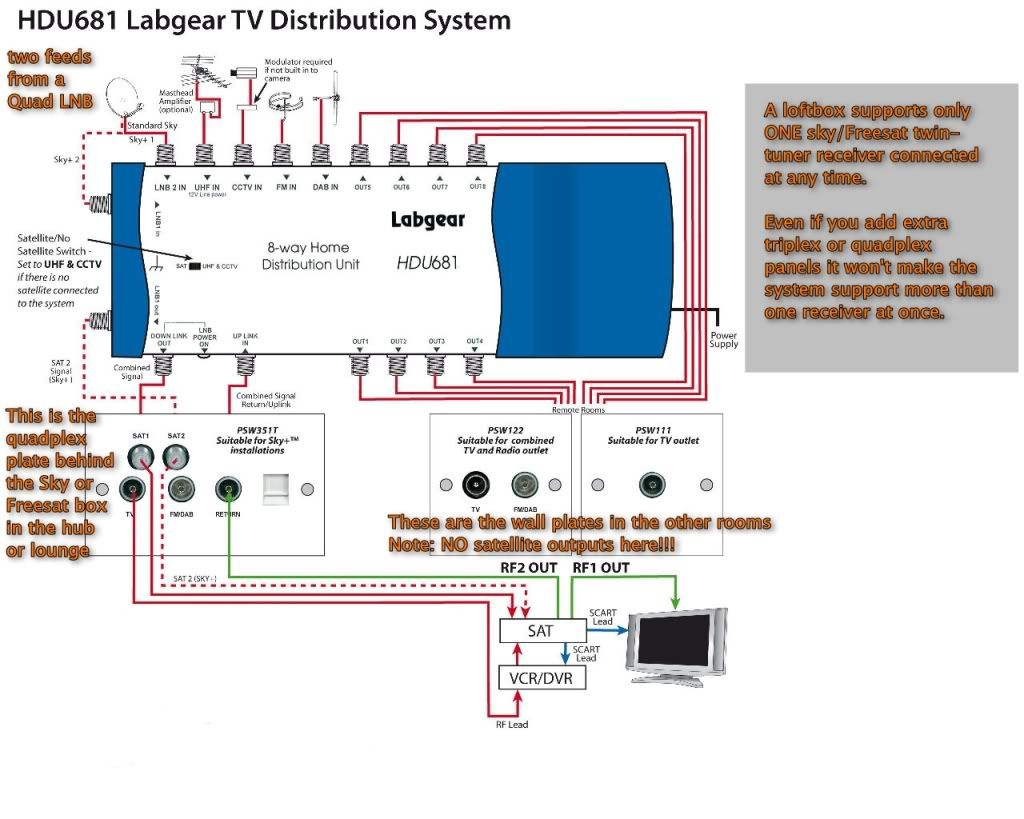Hullo. Newbie so please be gentle...
I'm refurbishing a house (i.e. completely gutting and starting again including rewiring). We don't watch TV much (currently don't even have freeview) but want to put in the wiring to allow for as much flexibility in future as possible.
This is what I'm planning to do - I'd appreciate any comments / suggestions:
1. Install Freeview Satellite and Freeview Aerial on roof.
2. Run 5 x coax cable from roof to hub three floors below
3. Run 2 x coax cable from hub to each room in house
4. Put quadplex plate in each room (http://www.tlc-direct.co.uk/Products/CX241M.html)
Note that at the moment I'm not trying to work out what I want to watch on it, what kind of switching / how many boxes etc I want. I just want something on the roof (because of access while scaffolding is up) and wiring that will enable me to do pretty much anything in the future.
My understanding is that 5 cables from the roof to the hub will allow for any combination of satellite / tv aerial / fm aerial that one might sensibly want, and that 2 cables from the hub position to each room will allow for all the variations of feeds to and from rooms you might want for most multiroom configurations.
I should add that I am also putting in a Cat 5e network which will have 2 cables to each TV point as well. I have been advised that in a domestic setting the chance of getting Cat 6 installed to a standard which would deliver its enhanced performance over Cat 5e is slim.
Does this all sound sensible? Anything I'm missing?
I'd particularly appreciate recommendations for both the coax and network cable.
I understand the coax should have impedance of 75 ohm. Would something like this do me: http://www.bryant-unlimited.co.uk/iqs/cpti.570/dbitemid.503/sfa.view/cables.html
Regarding the Cat5e cable, the main choices seem to be whether the shielding is F/UTP or U/UTP (?) and whether the conductor strand is solid or shielded. Any advice on this choice gratefully received, as my technical knowledge doesn't extend much beyond picking a pretty colour.
(I should also add that an electrician will be actually running all the cable, I just want to make sure I spec the right cable to go in.)
Thanks in advance!
I'm refurbishing a house (i.e. completely gutting and starting again including rewiring). We don't watch TV much (currently don't even have freeview) but want to put in the wiring to allow for as much flexibility in future as possible.
This is what I'm planning to do - I'd appreciate any comments / suggestions:
1. Install Freeview Satellite and Freeview Aerial on roof.
2. Run 5 x coax cable from roof to hub three floors below
3. Run 2 x coax cable from hub to each room in house
4. Put quadplex plate in each room (http://www.tlc-direct.co.uk/Products/CX241M.html)
Note that at the moment I'm not trying to work out what I want to watch on it, what kind of switching / how many boxes etc I want. I just want something on the roof (because of access while scaffolding is up) and wiring that will enable me to do pretty much anything in the future.
My understanding is that 5 cables from the roof to the hub will allow for any combination of satellite / tv aerial / fm aerial that one might sensibly want, and that 2 cables from the hub position to each room will allow for all the variations of feeds to and from rooms you might want for most multiroom configurations.
I should add that I am also putting in a Cat 5e network which will have 2 cables to each TV point as well. I have been advised that in a domestic setting the chance of getting Cat 6 installed to a standard which would deliver its enhanced performance over Cat 5e is slim.
Does this all sound sensible? Anything I'm missing?
I'd particularly appreciate recommendations for both the coax and network cable.
I understand the coax should have impedance of 75 ohm. Would something like this do me: http://www.bryant-unlimited.co.uk/iqs/cpti.570/dbitemid.503/sfa.view/cables.html
Regarding the Cat5e cable, the main choices seem to be whether the shielding is F/UTP or U/UTP (?) and whether the conductor strand is solid or shielded. Any advice on this choice gratefully received, as my technical knowledge doesn't extend much beyond picking a pretty colour.
(I should also add that an electrician will be actually running all the cable, I just want to make sure I spec the right cable to go in.)
Thanks in advance!


